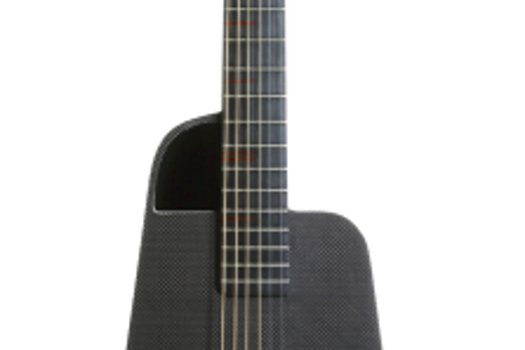


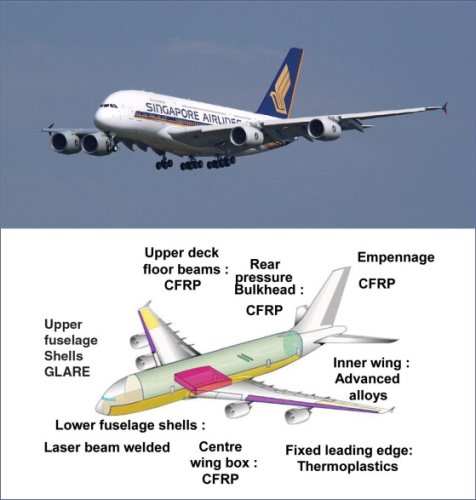
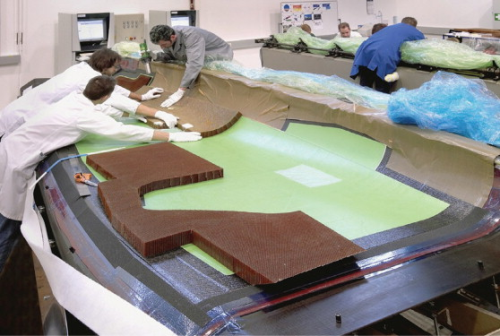
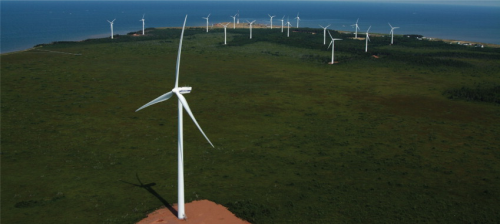

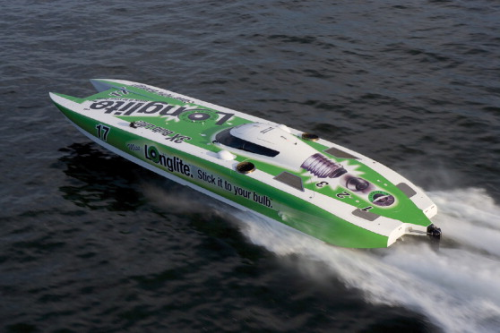
The last peak period for carbon fibre production occurred between 1996 and 1999, and the next peak may begin in 2009. Every carbon fibre supplier has announced capacity expansions, but guards competitive details closely, even ‘stealthily.’ Recent optimism from original equipment manufacturers (OEMs) sets out to capture the high-performance advantages of carbon fibre over a diverse range of products. In the commercial aircraft sector alone, Boeing predicts that the need for new airplanes over the 2007 to 2026 time frame will reach 28 600, with the air cargo fleet doubling and passenger traffic tripling to 6.8 billion.
A surge in air passenger travel in recent years, particularly in Asia and Europe, has helped drive this thirst for new airplanes. The Airbus Global Market Forecast 2006-2025 predicts that 22 700 passenger and freight aircraft will be required by aircraft operators. Both these OEMs are leading the way in significantly increased use of structural onboard composites, including carbon fibre, most recently in B787 and A380 aircraft.
As of December 2007, Airbus had 189 orders for the A380, a 277 tonne jumbo jet that uses carbon fibre composites in 22% of the aircraft, including primary structure. Launch customer for the A380 is Singapore Airlines, which took delivery of its first aircraft last October. As of mid-January, 2008, Boeing announced 857 orders logged for its 787. The single source for carbon fibre/epoxy prepreg in the 787 programme is Tokyo-based Toray, and the two companies have signed an 18-year supply contract for Torayca prepreg through 2021. The value of the contract for primary structure on the 787 has been reported at €2.03 billion (US$3 billion).
If all this interest in carbon fibre translates to firm purchase commitments, is there enough material to go around at an affordable price? Reinforced Plastics conducted an informal survey within the industry to get a take on the vagaries of supply and demand, not only from global carbon fibre suppliers but also companies of varying size that use carbon fibre to fabricate parts or composite moulds. Top US consultants, who have been monitoring this supply/demand ratio, also weigh in.
Supply won't keep up
That's the opinion of Ben Rasmussen, President of consulting firm BMR Associates of North Plainfield, New Jersey, USA, and he hasn't wavered in his perspective for the past three years, despite the upcoming carbon fibre capacity increases.
“Additional investment and capacity will be required by 2020,” he states, “though precursor will not be an issue.”
Nonetheless, he calls the reinforced plastics industry ‘robust’ and projects that global demand of polyacrylonitrile (PAN)-based carbon fibre will reach 50 000 tonnes by 2010, 60 000 tonnes by 2012, and 100 000 tonnes by 2020.
Rasmussen notes that the seven major carbon fibre manufacturers (Toray, Toho-Tenax, Mitsubishi Rayon Co, SGL, Hexcel, Cytec, and Zoltek) “have announced plans to increase production capacity by 78% over the next three to five years, at an overall investment of €879.7 million ($1.3 billion).”
Tony Roberts, president of AJR Consulting LLC in Lake Elsinore, California, USA, agrees with Rasmussen – sort of. His global carbon fibre demand projections are relatively close: 45 940 tonnes by 2010, 55 160 for 2012, and 65 425 tonnes by 2014. Regarding the capacity expansions just now getting underway, he says: “It takes two years for an existing supplier to bring on a new carbon fibre production line, and about three and half years for a new supplier. In the short term, I don't see carbon fibre demand reaching today's optimistic levels, but it's possible supply may exceed demand in 2012. Until then, Boeing, Airbus, and defence projects will be able to acquire all the carbon fibre they need, with the balance sold for industrial sector applications.”
Roberts bases his opinion on 35 years in the composites industry, including stints with Courtaulds, Grafil, Mitsubishi Rayon Co, and Newport Adhesives and Composites.
“Supply will not exceed demand, and we will run short again in 2009, even with a recession in the US,” suggests Richard O'Meara, President of Core Composites, Newport, Rhode Island, USA (a division of ROM Development Corp). The distributor sold about 45.3 tonnes (100 000 lbs) of carbon fibre fabric and prepreg in 2007, mainly to the marine market, where O'Meara expects 20% growth per year over the next five years.
“The aerospace market is given priority, but new industrial and marine applications are coming on,” he notes.
At Exit Engineering Srl, a fabricator of carbon fibre/epoxy structural parts for leisure sailboats in Venice, Italy, Giuseppe Bottacin, Technical Director and Co-Owner, reports that: “My own suppliers are still advising me to be careful when accepting large production requests from customers. Our demand for carbon fibre in 2007 grew by about 50%.”
John Davidson, managing director of Milled Carbon Ltd, Warwickshire, UK, a company that developed the CARBONCLEAN process to recycle carbon fibre waste into reusable form, takes the stance that: "In the short term, any extra capacity will be consumed rapidly. Many users are finding it difficult to obtain carbon fibre, and are taking whatever they can get. In the medium term, price will determine whether demand will outstrip supply.”
He also says that from the standpoint of sustainability: “It may not be too far in the future when we see a shortage of the raw materials needed for precursor production, which are petroleum based.”
Carmen Daniels-Leslie works with all international suppliers to buy and sell carbon fibre (about 20.4 tonnes or 45 000 lbs in 2007), from dry fibre to prepreg, for Daniels Fibers Inc, Fountain Valley, California, USA. She draws on her own experience in 2007 regarding insufficient supply.
“I now import fibre from the former USSR and another country to meet my prepregger and weaver demands," she says. "I don't believe the capacity expansions announced so far will meet the current demand, much less future needs of both aerospace and non-aerospace applications.”
From a different tack, Marc Shrief, Global Sales and Marketing Director for German fabric supplier Saertex, believes: "Supply will exceed demand as major programmes will be delayed, and while capacity is ramping up.”
Saertex supplies around 454 tonnes (about 1 million lbs) of carbon fibre fabric annually. In line with Shrief's assessment, a source from one of the major Japanese-owned carbon fibre suppliers also apprises that, in the aggregate, supply should exceed demand over the next five years, with spot shortages for 3K and 6K carbon fibre used in aerospace fabrics.
Maybe consultant Dee J. DeLong, General Partner in DeLong and Associates LLC, Atlanta, Georgia, USA, represents the middle ground perspective.
“Supply will only modestly exceed demand over the next five years, due to commercial aircraft build rates," he notes. "A little oversupply is a good thing when the industry is growing at 15% a year.”
Rasmussen agrees with this double-digit growth figure in terms of compound annual growth rate (CAGR) from 2007 to 2014, whereas Roberts' forecast is 11% relative to CAGR 2006-2014. He thinks the industry as a whole has its sight set on 13% as realistic, with the most hopeful figure an outside chance at 17%.
A spokesperson from GKN Aerospace, a leading European fabricator of complex composite structures using about €269.2 million ($400 million) worth of carbon fibre annually, states that: “The carbon fibre producers are scaling up operations to fulfill the demand from aerospace growth in new models, so these growth figures are realistic. The actual consumption will follow the actual rates of new aircraft delivery, which is less certain. The supply curve is finely balanced, and we consider that program allocation will be a force in the industry over the next three to four years at least.”
Multiple market drivers
The three consultants here agree that aero-space and environmentally positive or ‘green’ products such as wind energy systems encompassed the strongest market drivers for carbon fibre useage in 2007. Perhaps representative of this: talks reported in the fourth quarter between Boeing and Toray to increase their supply agreement so that enough Torayca prepreg will be produced to enable an increased build rate of 10-14 shipsets per month, by 2010.
In terms of wind energy systems, turbine producer Vestas, with headquarters in Randers, Denmark, predicts that the wind power share of global power consumption will increase up to 10% by 2020. The company utilises carbon fibre in load-bearing spars on wind turbine blades, and has installed nearly 34 000 turbine systems to date.
As of 1 January 2008, OEM Gamesa, of Bilboa, Spain, reports over 8000 MW of committed orders internationally for wind generators, and 3000 MW of completed installations.
“Wind power applications will drive growth volumes for large tow (24k) carbon fibre producers,” DeLong projects. “The global need for clean energy will again allow the producers for this end-use to continue to invest.”
“The use of carbon fibre in wind energy blades is projected to be the second largest application after aerospace by 2010," Rasmussen adds. "Europe and Asia are far more advanced in this area than the US.”
“Wind installations are growing at an accelerating rate, with a trend toward larger turbines with longer blades that use more carbon fibre content,” DeLong assesses. Further, he states that this is a market segment that is somewhat difficult to forecast: “because every wind blade producer has different plans for including carbon fibre in their designs. There is no easy ‘rule of thumb’ for carbon fibre per blade for the industry.”
He explains: “In 2008, the estimate for installed new wind capacity is around 19 000 MWT, with a mix of turbine sizes. If the average size is 2.5 MWT, then 7600 turbines will be installed. The number of blades on that many systems is estimated at 22 800. How much carbon fibre is contained in each blade? The range is zero to 1.5 tonnes.”
This is a supply quandary with great challenge in the stealth decoding, indeed.
Diversity, technology
Survey sources all responded that more diverse end-uses for carbon fibre seem to be emerging now as compared to the previous peak period. Warren Schimpf, President of Advanced Fiber Technologies Inc, Wilmington, Delaware, USA, comments: “What separates this supply and demand cycle from those previous is that there are so many new applications that are using or will use large quantities of carbon fibre.”
His company does contract R&D, testing and composite fabrication, primarily for government and military agencies, and used or supplied about 90.72 tonnes (200 000 lbs) of carbon fibre in 2007.
From Rasmussen's viewpoint: “End-use applications are greater now than the late 1990 period because many applications have passed the R&D stage and reached commercialisation.”
“End uses are rising exponentially," says Milled Carbon's Davidson. "As recyclers, we're being asked for material for some rather unusual applications, such as strings for musical instruments.”
Daniels-Leslie reports supplying two companies which recycle dry fibre for bike helmets.
O'Meara adds that marine applications are growing out of “a desire to save fuel with lighter boats, to go faster with race boats, and to keep weight aloft lower for mega yachts.”
Arno Seyfert, director of Custom Works Composite Engineering, Jeffreys Bay, South Africa, verifies that sports products continue to benefit from carbon fibre, not only for performance but also appearance. His company fabricates components for the motor racing industry, especially the VW S2000 Rally Polo vehicle, as well as custom components for racing yachts, bikes, and aircraft. These components are made using out-of-autoclave technology, Seyfert says, with comparable autoclave/prepreg quality.
Roman Nykyforuk, Business Manager for Specialty materials at Asbury Graphite Mills, Asbury, New Jersey, USA, cites new applications coming for tank products. In particular, this will be true “if the fuel cell industry starts using carbon fibre in [commercial] hydrogen storage tanks.”
Changes in materials and manufacturing technology are also affecting carbon fibre demand by opening up end-use applications. Nearly every respondent in this survey mentioned the development of nanocomposites, and about a third listed increased emphasis on carbon fibre/thermoplastic composites. Rasmussen points to R&D in new precursors and improved fibre/resin interface, as well as recycling technology in creating feedstock for the milled/chopped composite requirements of electro-magnetic interference (EMI)/radio frequency interference (RFI) shielding in electronic components.
Exit Engineering's Bottacin believes resin infusion and resin transfer moulding (RTM) “fill the gap between very low cost methods and autoclave curing,” with DeLong noting that “existing processes such as RTM and autoclaving are increasing their use of automation to reduce labour. In a similar fashion, tape lay-up has progressed to high-volume tape winding on the 787 fuselage sections. The really fast cycle times will come from fast moulding processes with thermoplastic tape and long fibre reinforced thermoplastic (LFRT) injection moulding.”
He also mentions the Fiberforge carbon sheet moulding compound (SMC) thermoplastic process, and the innovation of Quickstep's liquid-based heat transfer process as a faster option to air transfer in an autoclave: “Taken as a whole, you can see the level of effort being made to reduce process costs.”
GKN comments that: “Component manufacturers have done a great deal through clever use and automation to reduce piece part price, which has led to wider scale use of carbon fibre composites, especially in aircraft structure. We see weight savings ranging from 15 to 30% occurring in at least 60% of the structure using composites.”
Price point
Cost remains the crucial factor in using high-performance composites. There's nothing stealthy or undisclosed in this statement from a source at a major carbon fibre supplier: “Despite considerable discussion of all these technologies, it still boils down to the cost of performance.”
Survey participants were asked if they thought carbon fibre or carbon fibre composite price would come down in the next five years if supply increases, and no single mindset for this answer presents itself.
“Carbon fibre price has been primarily about supply and demand, as carbon fibre is a commodity,” says the president of a composites fabricator/second source supplier based in California, USA. “The price of carbon fibre in the marketplace has increased by over 100% in some cases over the last few years. Yet with the increase in oil prices over the last year, the price has stabilised or slightly decreased.”
This company supplies continuous fibre thermoplastics and also fabricates components, about 15 million a year, including athletic footwear, hockey skates and blades, and kayak paddles. This source also believes: “Prices have reached a point of potential equilibrium as profits to the manufacturers are acceptable. If the supply exceeds demand by too much margin, then the prices will drop.”
Joel Walworth, Owner of Applied Vehicle Technology, Indianapolis, Indiana, USA, sells carbon fibre to customers in the motorsports industry, and told Reinforced Plastics he's had no problem getting the quantity of dry fabric or prepreg he's needed in 2007. For those materials, he has seen prices ($19-25/linear yard) decrease somewhat. He sells about 18 000 to 20 000 linear yards/year, mostly 3k.
Core Composites' O'Meara also views prices as stabilising over the next five years: “We have gone past the big increase phase, and the suppliers have healthy margins that will sustain investment. The converters will always fight for the last 5% but the big 25% price fluctuations are over for good in my mind. The price of carbon composite products are a good value at today's level.”
“Commercial fibre can now be bought for filament winding and weaving at $18/lb, while aerospace fibre sits at $55-$100/lb [these fibres may have higher modulus]," offers Daniels-Leslie. "If the 787 and Airbus keep supply tied up, US prices won't come down, but competition will.”
Advanced Fibre Technologies' Schimpf believes that “energy prices will continue to impact carbon fibre prices from both the cost of precursor and conversion costs.” Consultant Roberts remembers the bottoming out after the last production peak “that scared carbon fibre users who couldn't get it anywhere at any price.” He concedes that “selling price softens with increased supply,” but believes conversion technology is the ultimate limiting factor in terms of the price of carbon fibre. “That's why we can never make carbon fibre for $5/lb no matter what we do.”
Certainly no one expects the leading carbon fibre suppliers to jeopardise their competitive edge by revealing exact production efficiencies, specific timelines for new capacity to come on line, or what encouraging signals OEMs may be sending during confidential negotiations. Credit can be given for significant decoding of the intense volume of publicly disclosed carbon fibre supplier data in detailed market reports such as the one Roberts compiled in 2007, The Carbon Fibre Industry: Global Strategic Market Evaluation: 2006-2010. Bottom-line, there's still no better way to decode the ‘stealth factor’ of proprietary business strategy (albeit protective) for global carbon fibre supply and demand than to talk with insiders operating in the reinforced plastics industry.


